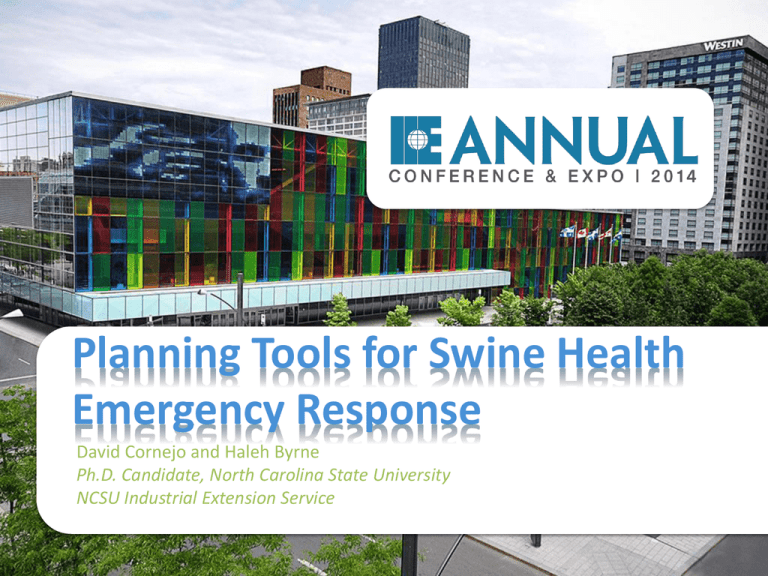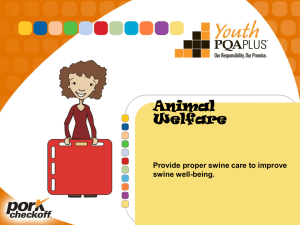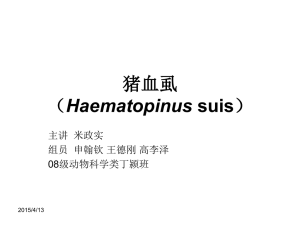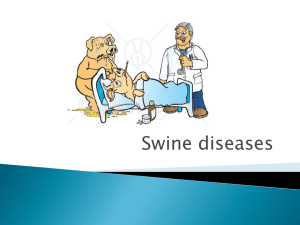Simulation Model - X-CD System Conference Management
advertisement

Planning Tools for Swine Health Emergency Response David Cornejo and Haleh Byrne Ph.D. Candidate, North Carolina State University NCSU Industrial Extension Service Team members • Presentation Co-Authors: • David Cornejo- NCSU Operations Research • Haleh Byrne-NCSU Industrial Extension Service • Animal Science/Engineering Collaborators: • William Morrow –NCSU Animal Science • Larry Stikeleather- NCSU Bio & Ag Engineering • Craig Baird –NCSU Bio & Ag Engineering • Robert Meyer – Mississippi State, College of Veterinary Medicine • Darrel Styles – USDA Funding Acknowledgement: USDA APHIS cooperative agreement and a Department of Homeland Security Science and Technology Division Interagency Agreement (System to Administer Inhaled Gases for Mass Depopulation of Swine in a National Emergency, Agency Reference Number: 09-9137-1280-CA) Horia Varlan - Creative Commons, Flickr 2 Problem Statement • Major outbreaks of swine diseases are not common, but are economically devastating. • Containment requires mass euthanasia. • Effective, humane euthanasia practices can be developed and tested on a small scale. • Simulation can estimate the resources required to scale-up process to disaster response proportions. 3 Outline • Background on swine health epidemics. • Summarize new, humane euthanization method developed. • Present simulation model developed to scale new techniques. • Demonstrate how model was utilized to develop strategic and tactical decision aid. 4 Swine Health • Swine diseases • Foot and Mouth, Swine Flu • Aersolisable=Spread though the air • While pigs are alive generating more aerosolized vectors. • Mass Depopulation allows containment. • Timely depopulation reduces total morbidly and economic cost. 5 Effective Depopulation • Primary Goal: Minimize Time • Minimize • Resources required • Animal handling • Ensure proper disposal 6 New Depop Procedure 1. 2. 3. Swine loaded onto trucks. CO2 gas pumped into containment. Burial • Process tested and evaluated measured on small scale at research farm. Reference: Robert E. Meyer, W.E. Morgan Morrow, Larry F. Stikeleather, Craig L. Baird, J. Mark Rice, Haleh Byrne, Burt V. Halbert, Darrel K. Styles. Administration of carbon dioxide for onsite mass depopulation of swine in response to animal health emergencies. Journal of the American Veterinary Medical Association 2014; 244(8): 924-933 • Create Simulation Model to determine resource requirements on disaster scale. 7 Simulation Model Jobs, Innovation, Growth, Stability www.ies.ncsu.edu 8 Mass Depop Process • 4 Distinct Stages • Moving pigs from house to loading slot • Loading pigs onto available farm truck • Preparing trucks and gasification • Disposal of carcasses • METRIC: Time to complete process. 9 Moving Pigs from house to truck • Influenced by following user inputs • Pigs: Number, Weight class • Houses: Number, Size, Loading Slot length • Workers: Number available • Variables affect Travel Time of run. • Calculated travel time parameterized travel time distribution(stochastic travel time). 10 Using Time-in-Motion for Data Collection • Walk speed data was collected using a Time-in-motion study. • Timer Pro was utilized to collect data from videos of truck loading operations. • Multiple observations were used to develop simulation distribution parameters. 11 Data that supports calculations • Weight classes Class Name Nursing Weaning Finishing Breeding Boar/Sows Weight Range (lbs) ≤70 70-100 ≥100 ≥200 • Run Size/Walk Speed Class Name Run Size 1 Handler Rate (ft/min) Nursing Weening Finishing Breeding Boar/Sows 21 9 5 1 107.59 209.975 240.385 625.734 12 Load Truck • Pigs Loaded onto truck • Capacity of trucks from pig weight class Class Name Nursing Weaning Finishing Breeding Boar/Sows Space Requirement(sq. ft./pig) 1.09 2.635 3.48 5.55 • Assumed 15 seconds to load each pig • Details • One or two loading slots available • Handler will wait with run until truck arrives 13 Preparing Trucks for Gas • Before each application of gas some preparation (check tarp, attach hose etc.) • Assumed to take between 5 and 10 mins with a mode of 10 mins • May physically take place at gas location. 14 Administer Gas • Applied for minimum of 5 minutes. May take longer. • Applying gas consumes available stock. • Process halted when no more gas • Gas can be delivered on intervals. • Sublimation a way to extend gas stock 15 Dispose of Carcasses • “Dwell Time” of 10 minutes included in minimum travel time to Disposal Site. • Assumes can travel immediately after gas • No particular time allocated to disposal • Trucks take time to return to loading slot 16 Statistics Monitored • Time To Terminate: How long to cycle all pigs • Average Walk Time: Average Time spent with Handler(until loaded on truck) • Accounts for walk time and queuing for truck • Average Time in Gas Process: From starting to load until disposal. • Accounts for queuing at constrained gas resources 17 Parameters and Control Variables • Farm Parameters • Size of House • Size of Pin • Number/Length of Load Slots • Truck Controls • Truck Size • Number of Trucks • Handler Controls • Number of Handler • Handler Efficiency • Special Process Parameters • Dry Ice recovery process option 18 Planning Tools using Simulation Jobs, Innovation, Growth, Stability www.ies.ncsu.edu 19 Simulation Model to Practical Tool • Simulation Model can optimize handler worker combination given number of trucks for a specific scenario. • Disaster planners want to get estimates for a wide array of planning scenarios or on the fly “what-if” scenarios. • Most interested in obtaining resource estimates to complete the operation in a specified time window. • Farmers do not want to interact with the simulation model. Web App Solution • Best resource solution form a large array of scenarios batch run in simulation model. • Results stored in database. • Web application exposes relevant controls to decsionmaker and calculates resource requirements based on stored simulation results. • Web app runs fast (seconds) and requires no specialized software. 21 Web App Screen Shot 22 Web App Output Page 23 Conclusion • Swine health disasters deserve advance planning. • Simulation provided a viable method for estimating the requirements when scaling up a new process. • Data was collected through careful studies of portions of current processes. • Results of simulation model were encapsulated in web application. • Web application requires no special software or training to use. 24 Questions? Jobs, Innovation, Growth, Stability www.ies.ncsu.edu 25









